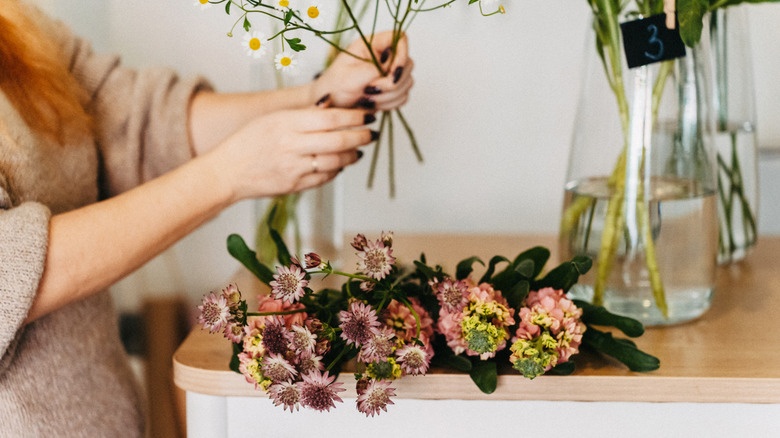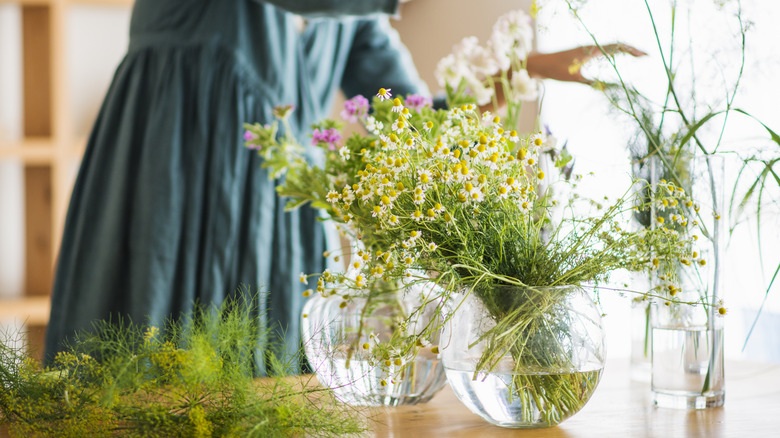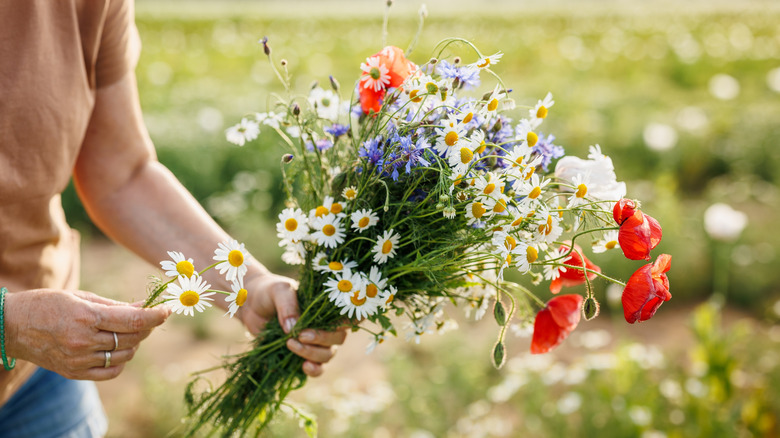How To Arrange Wildflowers In A Bouquet To Look Intentional
So you've jumped on the wildflower trend, you figured out where to go to pick fresh wildflowers, and you've rounded up a lovely array of blossoms to turn into a beautiful bouquet. Now what? How do you achieve that perfectly imperfect, messy yet modern, wonderfully whimsical bouquet look? We had the same question, so we turned to floral expert Nicole Dillon — a micro-flower farmer and the owner of Breemar Flower Farm in Ashland, Virginia. She cultivates sustainable, earth-friendly blooms and also helps gardeners of all skill levels grow their hobby. Speaking exclusively with House Digest, Dillon says wildflowers are trending for good reason. "They are romantic yet nostalgic," she says, adding, "It's easy to create a one-of-a-kind piece when using wildflowers because there are so many different textures, colors, and unexpected elements."
To make your wildflower bouquet look intentional, first sort your wildflowers by type. "Foliage, Line, Focal, Filler, Air. This is the exact order that I line up my flowers and prepare before I start arranging," Dillon shares. In case you aren't familiar with these terms, they essentially comprise the anatomy of a floral bouquet. Foliage refers to the greenery pieces, while line flowers have tall blooms that add height to the arrangement. Focal flowers are, you guessed it, the stars of the bouquet, while filler flowers are more subtle, adding structure and support in the background. Finally, airy florals help lighten up denser areas of the bouquet, adding pops of lightness for contrast and depth. "I also further strip any leaves I won't be using and break up branching stems into more manageable pieces," Dillon says, explaining that this streamlines the process and provides a clear view of your materials.
How to arrange your wildflowers like an expert
Speaking exclusively with House Digest, Dillon advises to always base your wildflower bouquet on a color palette. While it's tempting to create a formula of specific flowers, allowing the color and shape of flowers to guide your design will make better use of the wildflowers at your disposal. "Stick to 2-3 colors and then use neutrals and foliage to tie everything together," Dillon says. As she explains, "It can look busy if you throw everything you have growing in your yard into one arrangement." Similarly, Dillon says that while floral variation is key to an intentional bouquet, you can just stick to a few flower categories mentioned above. "Try to hit a minimum of three of these types of flowers," she advises. Of course, you could also make a single-flower bouquet to incorporate the wildflower trend into your next tablescape or floral display.
Once you have arranged your bouquet using your flower categories, Dillon recommends using chicken wire, floral frog, or floral tape to secure it in a vase. While the hand-tied look is very on trend, Dillon says it's not easy. If you want to try it, Dillon says, "First, hold the first stem at an angle in your non-dominant hand. Next, keep adding stems, rotating the bouquet after each stem placement." She acknowledges the stems will move as you do this, so she advises moving the flowers up and down to create the look you want. "Varying heights add a ton of interest to the bouquet," she explains. Finally, once you are happy with the bouquet, use a bind wire or a rubber band to secure the bouquet tightly together before placing it in water.
Best wildflowers for bouquets and arranging mistakes to avoid
If you want to turn a patch of lawn into your own wildflower field, Dillon suggests several wildflower options that will make a great cutting garden. Speaking exclusively with House Digest, she recommends focal flowers like black-eyed Susan (Rudbeckia hirta), coneflower (Echinacea), and sunflowers (Helianthus annuus) along with line flowers including sage (Salvia) and larkspur (Delphinium). She suggests filler and airy wildflowers like bee balm (Monarda), yarrow (Achillea millefolium), and fennel (Foeniculum). Finally, she recommends incorporating foliage options like native grasses, mountain mint, and raspberry foliage. There are also some wildflowers Dillon would not recommend using in an arrangement. "Not everything is bouquet worthy," she says. "Some flowers will drop their petals when cut or drop pollen all over the table." She advises against dandelions, wild ferns, and wild thistles — as opposed to their cultivated counterparts Echinops and Eryngium – since they won't last long in vases.
Dillon is quick to remind DIY florists to prioritize bouquet hydration first and foremost. "When flowers are cut, they are thirsty. Fresh, clean water is important, and I always recommend cutting, letting a flower drink for a few hours (I prefer 24 hours) before arranging it," she says, adding that it's best to change the water daily after that. She also recommends always being sure to lead with focal flowers for a polished bouquet. "These big, bold blooms add structure to the arrangement and help draw your eye throughout the piece," she explains. Not every wildflower will be bouquet worthy, but Dillon says the best thing you can do is to keep experimenting, saying, "Try things, test things, and you might find a new unexpected flower or accent."


